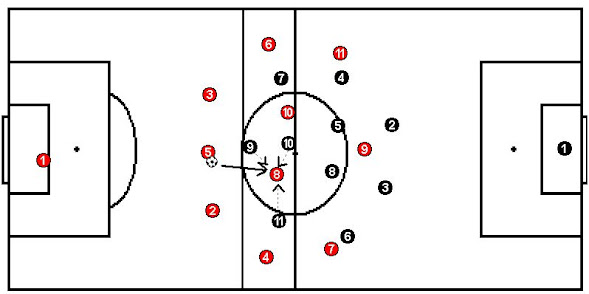Autor: Oscar Mendez.
Como se sabe dentro del deporte del fútbol, cuando la mayoría de equipos se encuentran en fase ofensiva, generalmente de acuerdo a los principios generales de juego de todos los deportes colectivos, se buscan determinados objetivos estratégicos que nuestro equipo explote.
Esto es elemental para todos los deportes colectivos.
Principios
Generales de los deportes colectivos.
1-
Crear superioridad numérica.
2-
Evitar igualdad numérica.
3-
No permitir inferioridad numérica.
Un problema que observamos reiteradamente, tanto a nivel de competencias de clubes y selecciones absolutas es como no se toma en cuenta este aspecto,
Se repite e
insiste en algo que muy probablemente no llegara a buen puerto o tendrá
consecuencias negativas para ese equipo, ya que perderá la pelota y será presa
para el equipo rival para ser contra-atacado fácilmente.
No tengo
claro a qué se debe, aunque sospecho que puede deberse a la incapacidad de los
entrenadores y futbolistas, a no poder percibir la acción siguiente o al juego como
un “Todo”(vision sistémica).
Actúan como si esa acción ofensiva se terminara inmediatamente, y el
juego no siguiera cambiando , donde el juego es una cantidad de acciones y
fases que siguen sucediendo de forma dinámica una tras otra.
El problema:
Cuando estos equipos construyen las acciones ofensivas desde atrás, existe una zona activa
y una zona pasiva
La zona activa se encuentra donde el bloque defensivo rival se encuentra posicionado. En este caso se posiciona o coloca en bloque medio o posicionamiento intermedio. (Equipo negro en este caso).
Cuando los equipos que se encuentran en Organización Ofensiva o Ataque Organizado, en construcción como mencione antes desde atrás, en cambio, los equipos que defienden suelen retrasar al o los puntas hasta posicionarse cerca de los medios defensivos, con el bloque muy corto y cerrado.
Además muchas veces, uno o los dos laterales del equipo en ataque, bajan como se observa en el
gráfico y el problema se acrecienta o agranda ya que la inferioridad numérica es aún mayor.
En otros casos suben los laterales aunque baja un Medio Centro creando en la zona activa un 7 contra 11.
Esto se puso de moda con la "salida lavolpiana" y se convirtió en una moda aunque claramente los que lo repiten, no entendieron para que se hacía o con que fines.
La pregunta es, si el equipo rival solo juega con un delantero, para que baja un Medio Centro si ya tiene el equipo rojo superioridad numérica?
A primera instancia se nos puede decir, generaremos así un 3 v 1.
La pregunta sería, y una vez que podamos entrar en esta zona activa, de este modo quedarán 7 v 11 (10 jugadores de campo + arquero/portero rival).
Esta inferioridad numerica que tenga el equipo en posesion- construcción, le alcanzará para seguir progresando y no perder la posesión del balón?
Muchos de los futbolistas rojos en este caso, serán doblados ante la presión del equipo negro.
Este “problema” se observa una y otra vez a todos los niveles.
1ero- Poder progresar.
Si logramos filtrar un pase a un futbolista nuestro en esta zona activa, se encontrará en gran inferioridad numérica y es muy probable que no pueda mantener posesión del balón o el equipo progresar.
2do- Inferioridad numérica para poder presionar.
Otro problema es como presionaremos trás pérdida para ganar inmediatamente el balón si estamos ante mucha inferioridad numérica?
Este problema también puede deberse a que se ve a la Posesión del balón como un fin, y no como un medio para llegar a algo.
Además de llevar al rival a donde intentaremos presionarlo inmediatamente embotellándolo y no dejándolo salir con presión trás pérdida para recuperar el balon y aprovechar la desorganización rival.
3ero- Crear y aprovechar espacio.
Saber como crear, y aprovechar espacios libres.
Esto primero los entrenadores deben saber como hacerlo, saber enseñarlo, y los futbolistas reconocerlo en situaciones reales de juego.
4to- El ritmo de juego.
Como dijo Alvaro Recoba, "no se corre igual cuando atacas que cuando defiendes".
El ritmo no puede ser el mismo cuando se presiona o se defiende sin balón que cuando se construye.
Sea porque todos los jugadores deben "viajar juntos", como para no perder la pelota y deben mantener un orden posicional , una organización para ofrecer de apoyo al compañero en posesión del balón.
El fútbol moderno tiene esta característica, nos guste o no.
5to- Falta de movilidad.
La movilidad también pasa a ser un aspecto clave, aunque siempre de forma posicional dentro del espacio que debo ocupar.
"La guarnición (Preparación Física) se ha comido al solomillo
(Juego del fútbol) ".
Juanma Lillo.














